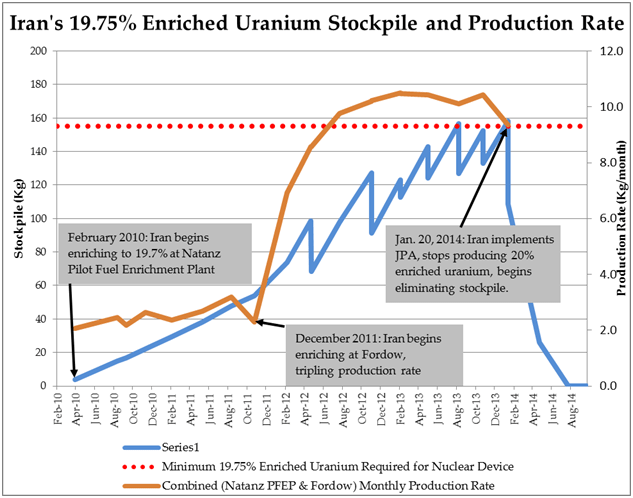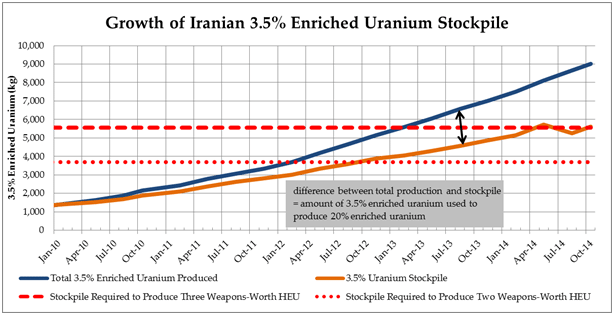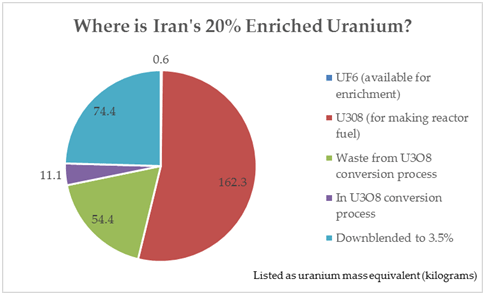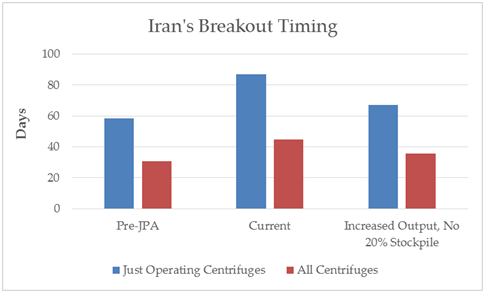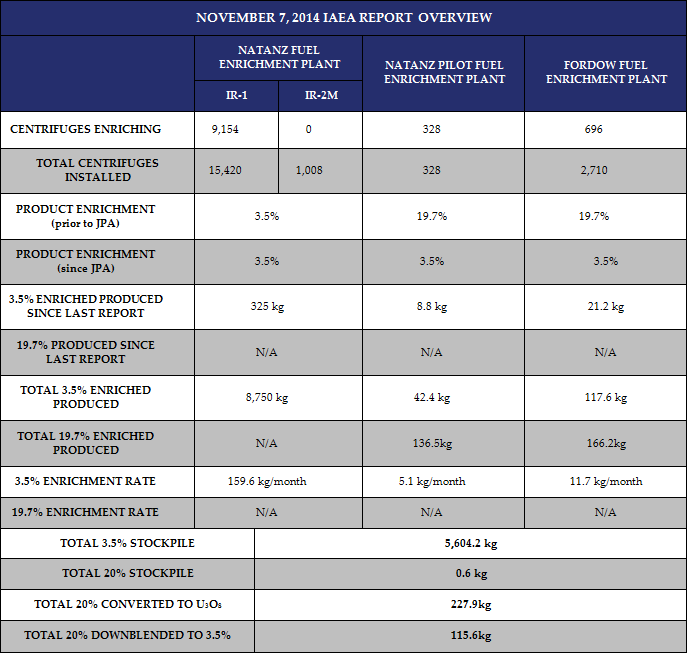Update on Iran’s Nuclear Program
Summary
- Iran has enriched uranium in a next generation IR-5 centrifuge that, under the interim Joint Plan of Action, should likely have remained inactive.
- Iran has also failed to convert roughly 1,000 kilogram of 3.5 percent enriched uranium into uranium oxide, as also required by the Joint Plan of Action.
- In a separate negotiating track with the IAEA, Iran has failed to provide timely information in three areas related to its alleged past research into military nuclear technology.
- This pattern of minor infractions serves both to set a precedent and to probe the international community’s willingness to punish transgressions.
Analysis
The latest report1 on Iran’s nuclear program by the International Atomic Energy Agency (IAEA), issued shortly before the November 24, 2014 expiration of the already once-extended interim deal, known as the “Joint Plan of Action” (JPA), suggests that Iran continues to test the boundaries of the current diplomatic process. As was already evident in the IAEA’s September 2014 report, Tehran is cooperative in talks with the P5+1 but is thwarting attempts by the IAEA to reveal the extent and nature of Iran’s past nuclear work. The latest IAEA report shows that Iran might be testing the limits of the JPA itself in two ways: activating an advanced centrifuge that had not been operational prior to the JPA and failing to cap its production of 3.5 percent enriched uranium during the deal’s term.
Continued Stonewalling on PMD
As discussed in a previous analysis, although much attention has been focused on negotiations between Iran and the P5+1 countries there has also been a parallel diplomatic track going on between Iran and the IAEA. Called the “Framework for Cooperation” (FC), the IAEA’s “approach [is] aimed at ensuring the exclusively peaceful nature of Iran’s nuclear programme” and gaining a better understanding of Iran’s past nuclear research, particularly on the so-called possible military dimension (PMD). Under the FC, the IAEA and Iran agreed to a set agenda of IAEA concerns for Iran to address and a timeline for doing so. Since November 2013, the FC has gone through three rounds, with a total of 17 issues raised: five in the first round, seven in the second and five in the third.
As of September 2014, Iran had responded adequately to 14 of those 17 issues. For one item in the second round, the IAEA asked Iran for additional clarifications in its response to one of the items, but “only certain of [those additional responses] Iran provided,” leaving the IAEA’s request unfulfilled. And for two items in the third round, Iran had completed only three of them and, of those, two were completed after the IAEA-imposed deadline.
All three of the unresolved issues have to do with Iran’s past nuclear research: explaining Iran’s experimenting with Exploding Bridge Wire (EBW) detonators, high explosives and neutron transport. These also happen to be the only three issues, of the seventeen taken up under the FC thus far, that were raised as area of concern in the IAEA’s 2011 annex. The fourteen issues on which Iran has been compliant, on the other hand, are unrelated with the possible military dimension of its nuclear program, focusing instead on current and ongoing activities.
In the two months since the September IAEA report, nothing has changed. As laid out in the most recent reports, despite multiple meetings between Iran and the IAEA, no progress has been made on the outstanding three items. Iranian negotiators have not been forthcoming on providing a civilian justification for their work in the three areas in question.
Moreover, Iran has proven uncooperative with the IAEA in other ways during the FC process. The latest IAEA report notes that a particular member of the IAEA’s technical team has been denied a visa from Iran four times, preventing them from being able to attend meetings and conduct investigations. Further, Iran has signaled an unwillingness to continue further with the FC, missing an August 2014 deadline to propose issues to be considered in the fourth round of the process. Finally, Iran remains obstinately resolute to block IAEA investigation into the issue that it considers the most pressing: possible Iranian experimentation with high explosives at the Parchin military facility. Not only has Iran prevented IAEA inspectors from accessing the site, but, according to the latest report, Iranian demolition of the site has “further undermined the Agency’s ability to conduct effective verification.”
Potential JPA Infractions?
The JPA, initially negotiated in November 2013 and implemented on January 20, 2014, was meant to be a six-month confidence building measure, designed to give both sides time to negotiate a comprehensive deal without the pressure of additional Iranian nuclear advances or international sanctions. That window proved insufficient and, in July 2014, the P5+1 and Iran announced a four-month extension of the JPA, to November 24, 2014. Now, it might seem that Iran has failed to fully comply with the terms of the JPA in at least two areas.
The Lone, Rogue Centrifuge
One of the centerpieces of the JPA was Iran’s commitment that “it will not make any further advances of its activities at the Natanz Fuel Enrichment Plant, Fordow, or the Arak reactor.” A footnote to this clause went on to specify that, “Iran will not feed UF6 [uranium hexafluoride] into the centrifuges installed but not enriching uranium.” It seems that Iran might have overstepped this boundary.
The Natanz plant, Iran’s main enrichment facility, is divided into two parts. An underground facility designed to hold 50,000 centrifuges, known as the Fuel Enrichment Plant (FEP), and an above ground facility known as the Pilot Fuel Enrichment Plant (PFEP). The latter is itself composed of two sections, one in which Iran enriches uranium?up to 20 percent prior to the JPA and to only 3.5 percent since the interim deal’s implementation?and another in which it conducts research and design activities on new centrifuge models. It is at this R&D section of Natanz that, as stated in the latest IAEA report, Iran fed a UF6 into an advanced IR-5 centrifuge that had previously been “installed but not enriching uranium.”
According to David Albright and the Institute for Science and International Security, “under the interim deal, this centrifuge should not have been fed with UF6,” which would mean that Iran’s actions constitute a violation of the JPA. Iran’s ambassador to the IAEA, Reza Najafi, has dismissed this suggestion. He told Reuters that, “So sometimes you feed, sometimes you do not feed. ? But it is ordinary R&D (research and development) and we are doing that. We continue with R&D.”
Indeed, as Najafi stated, the JPA does allow Iran “continue its safeguarded R&D practices, including its current enrichment R&D practices.” A further argument that Iran could make is that the “no further advances” clause of the JPA only explicitly mentions the Natanz Fuel Enrichment Plant, suggesting that the Natanz Pilot Fuel Enrichment Plant, where the IR-5 machine in question is located, was not subject to that limitation.
If anything, however, this lone centrifuge exists in the gray space of contested interpretation left in an imprecise agreement. Even though the JPA does not explicitly ban “further advances” at the PFEP, surely there are actions that Iran could take there that the P5+1 countries would consider a violation of the deal. If Iran, for example, tried to replace the 328 operating IR-1 centrifuges at that facility, currently producing 3.5 percent, with the advanced IR-2m model?potentially five times as efficient as the IR-1?that would almost certainly be a breach of its commitment to only “replace existing centrifuges with centrifuges of the same type.” So the PFEP, even if implicitly, is subject to the some of the same limitations as the FEP. But do those limitations also apply to the R&D part of the PFEP? It is entirely unclear.
It is that ambiguity, not just new technical designs, that Iran is exploiting and testing by activating this single IR-5.
Stockpile Overload
Another provision of the JPA was meant to ensure that Iran’s stockpile of 3.5 percent enriched uranium did not grow at all during the deal’s term. Specifically, Iran agreed to “convert to oxide newly enriched up to 5 percent during the six-month period.” Whereas UF6 is a gaseous uranium compound used for enrichment, uranium oxide (or UO2) is a metallic compound used in nuclear fuel rods. Although UO2 can be turned back into UF6 and enriched further that step adds additional time to a potential breakout attempt.
In order to comply with this provision, Iran had to build a new facility?the Enriched UO2 Powder Plant (EUPP)?to handle the conversion. The plant was not completed until May 2014, five months after JPA went into effect, did not begin operations until July 2014, at the very end of the initial the period, and the 1,500 kilograms of 3.5 percent enriched uranium that Iran produced during the first six months of the JPA were not converted into UO2 until August, after the first six months had elapsed.
On July 20, 2014, however, the JPA was extended for another four months and a similar provision was included. “Under this extension,” according the State Department, “Iran’s nuclear program will remain frozen and rolled back in key areas, including by continuing to cap the amount of 5 percent enriched uranium hexafluoride and convert any material over that amount to oxide.” During this second period of the JPA, Iran has produced roughly 1,000 kilograms of 3.5 percent enriched uranium. Yet, Iran has not converted any of it into UO2, despite no longer having to wait on construction of the EUPP.
The delay in conversion to oxide of the first batch of UF6 and the lack of conversion of the second batch of UF6 so far marks a very clear violation of the text of the JPA. It also serves to increase Iran’s existing stockpile of 3.5 percent enriched uranium.
Conclusion: Testing Resolve
This pattern of minor infractions serves to both set a precedent and probe the international community’s willingness to punish transgressions. The more often Iran is able to renege on its commitments, whether to the P5+1 or IAEA, the more it sets the expectation that such seemingly small violations are run-of-the-mill. And the greater the expectation for transgressions, the greater tolerance there is for them.
For this reason, the test of any comprehensive deal will be the ability to detect and will to respond to any similar transgressions of that agreement. As laid out, however, by the Bipartisan Policy Center’s (BPC) Iran Task Force, an acceptable comprehensive agreement with Iran will require, no matter the contents of a deal and no matter how long its duration, continued enforcement and vigilance from the United States and its partners. Vigilance will come, in part, from monitoring Iran’s compliance and will require continued support for the IAEA’s inspections efforts. It will also be incumbent upon the international community to demonstrate credibly to Iran’s leaders that there will be consequences if they attempt renege.
Additional details and highlights from the IAEA report include:
Production of 20 Percent Enriched Uranium Ceases, Stockpile Gone?
-
Per JPA, enrichment to 20 percent halted at Natanz Pilot Fuel Enrichment Plant and Fordow Fuel Enrichment Plant.
- Centrifuge cascades used to enrich to 20 percent at each site disconnected;
- IAEA installed additional safeguards to monitor that they remain disconnected.
- Total 20 percent enriched uranium produced since production began (Feb. 2010): 302.7kg.
-
Actual stockpile of 20 percent enriched uranium as of May. 2014: 0kg.
- JPA specifies that Iran must eliminate its entire stockpile of 20 percent enriched uranium.
- Half to be turned into reactor fuel;
- Half to be downblended to 3.5 percent enrichment level.
- Total of 228kg removed for oxidization (production of reactor fuel):
- 74.4kg downblended to 3.5 percent since Nov. 2013.
- JPA specifies that Iran must eliminate its entire stockpile of 20 percent enriched uranium.
?But Production of 3.5 Percent Enriched Uranium Jumps
-
On Jan. 20, facilities enriched to 20 percent switched over to making 3.5 percent enriched uranium.
- There are now three facilities enriching to 3.5 percent:
- Natanz Fuel Enrichment Plant;
- Natanz Pilot Fuel Enrichment Plant (previously producing 20 percent enriched uranium);
- Fordow Fuel Enrichment Plant (previously producing 20 percent enriched uranium).
- There are now three facilities enriching to 3.5 percent:
-
Total production rate remains nearly 15 percent above pre-JPA levels: 176.4kg/month.
- Slightly lower than in Feb. 2014 when it was at record high of 177.8kg/month.
- Natanz production rate of 3.5 percent at near all-time high of 160kg/month.
- Previous reporting period: 158kg/month.
- Highest recorded rate: 161kg/month (Nov 2012).
- Natanz PFEP production rate of 3.5 percent is 5kg/month.
- Highest recorded rate: 5.2kg/month (May 2014).
- Fordow 3.5 percent production rate of 3.5 percent down to 11.7kg/month.
- Previous reporting period: 14.2kg/month.
-
Total 3.5 percent enriched uranium produced since production began (Feb 2007): 9,018kg.
- 355kg produced since last reporting period:
- 325kg at Natanz;
- 9kg at Natanz PFEP;
- 21kg at Fordow.
- 355kg produced since last reporting period:
-
Actual stockpile of 3.5 percent enriched uranium as of November 2014: 5,604kg.
- 3,400kg used for enrichment to 20 percent or turned into uranium oxide for use in reactor fuel.
Iran Squeezes More out of IR-1 Centrifuges, Continues Researching New Models
- Per JPA, number and type of centrifuges largely unchanged at all enrichment facilities.
-
Natanz FEP:
- 16,428 total centrifuges installed (unchanged):
- 15,420 IR-1 centrifuges;
- 1,008 IR-2m.
- 9,180 IR-1 centrifuges operating:
- Same as previous reporting period.
- Equal to number operating in early 2013/late 2012.
- All operating centrifuges are IR-1 model.
- “Preparatory installation work” completed for more centrifuges:
- 2,016 IR-2m centrifuges;
- 6,050 IR-1 centrifuges;
- But no further work undertaken since JPA implementation.
- Output of operating centrifuges at near-record .76 SWU/machine/year.
- Previous reporting period: .75 SWU/machine/year.
- 16,428 total centrifuges installed (unchanged):
-
Natanz PFEP:
- 328 IR-1 centrifuges installed and operating (unchanged).
- Output of centrifuges producing 3.5%: .67 SWU/machine/year.
- Previous reporting period: .62 SWU/machine/year.
-
Fordow FEP:
- 2,710 IR-1 centrifuges installed (unchanged).
- Facility accommodates 2,976 centrifuges.
- 696 IR-1 centrifuges operating (unchanged).
- Output of centrifuges producing 3.5 percent: .73 SWU/machine/year.
- Previous reporting period: .89 SWU/machine/year.
- 2,710 IR-1 centrifuges installed (unchanged).
-
Research and development of advanced centrifuges continues.
- Iran experimenting with:
- 172 IR-2m centrifuges;
- 177 IR-4 centrifuges;
- 1 IR-5 centrifuge;
- 19 IR-6 centrifuges;
- 1 IR-8 centrifuge.
- Iran had fed uranium into:
- IR-2m centrifuges;
- IR-5 centrifuges;
- IR-4 centrifuges;
- IR-6 centrifuges.
- Iran experimenting with:
- Of these, the IR-5 had not previously been operated, making its use a potential violation of the JPA.
Fuel Conversion and Fabrication
-
Facility for conversion of 3.5 percent uranium hexafluoride into uranium oxide finally completed.
- Iran has oxidized 1,505kg of 3.5 percent enriched UF6.
- No oxidization has taken place since August 2014.
- Since then, Iran has produce roughly 1,000kg of 3.5 percent enriched UF6 that, under JPA, should have been converted into UO2.
-
Conversion of 20 percent enriched uranium hexafluoride into uranium oxide and fuel plates for Tehran Research Reactor continues.
- Total 20 percent enriched uranium fed into conversion process: 228kg.
- Total 20 percent enriched U3O8 produced: 162.8kg.
- 4kg 20 percent enriched U3O8 produced in waste.
- Means that about another 11kg 20 percent enriched U3O8 are still being processed.
- Total of 30 fuel assemblies for TRR have been produced.
- Of these, 28 transferred to TRR.
- Represents over a decade worth of fuel for TRR.
- IAEA verifies no reconversion of U3O8 into UF6, a possible sign of breakout, currently ongoing.
Heavy Water Reactor
-
Per JPA, no work has taken place at Arak Heavy Water Reactor since last report.
- Production of fuel assemblies for Arak has also ceased.
Framework for Cooperation
-
Iran did not adequately answer IAEA requests for explanation of why it was testing Exploding Bridge Wire detonators.
- Iran claims that it experimented with these devices, which can be used in nuclear weapons, for use “in the oil and gas industry.”
- The IAEA found these claims to be “not inconsistent with specialized industry practices,” but requested additional clarifications.
- In regards to those additional clarifications, the IAEA says “only certain of [them] Iran provided.”
- In response, the IAEA Director General has said that the full extent of Iran’s nuclear research and intentions cannot be determined with just the information Tehran has provided to date. Instead what is needed is, “acquiring an understanding of each issue in turn, and then integrating all of the issues into a “system” and assessing that system as a whole.”
-
Iran has also failed to provide complete and adequate answers to two other PMD issues raised in the third round of the Framework for Cooperation:
- Information with the Agency with respect to the allegations related to the initiation of high explosives, including the conduct of large scale high explosives experimentation in Iran;
- Information related to studies made and/or papers published in Iran in relation to research into neutron transport of compressed materials.
- Iran has not proposed issues to be addressed in a fourth round of the Framework.
Military Dimensions
-
IAEA reiterates that few of its concerns about possible military dimensions to Iran’s nuclear program have been addressed.
- As a result, report notes that, “while the Agency continues to verify the non-diversion of declared nuclear material at the nuclear facilities ? declared by Iran under its Safeguards Agreement, the Agency is not in a position to provide credible assurance about the absence of undeclared nuclear material and activities in Iran, and therefore to conclude that all nuclear material in Iran in peaceful activities.”
Effect on Timing
Two main variables will determine how much time Iran would need to produce 20 kilograms of 90 percent enriched uranium?the minimum needed for a nuclear weapon?in the near future: its available stockpile of 20 percent enriched uranium and the rate at which its centrifuges are able to enrich uranium. The first has declined to zero as a result of the JPA, increasing breakout timing. But the latest IAEA report shows that the second has increased since the JPA’s implementation, somewhat mitigating the effect of Iran’s loss of its 20 percent enriched uranium stockpile.
- Depending on whether Iran uses just its all of its installed centrifuges or just the currently operating ones, Iran could produce 20 kilograms of highly enriched uranium, enough for a weapon, in between 45 and 87 days.2
-
This result is in line with Obama Administration estimates that the JPA would add a month to Iran’s breakout timing.
- In November 2013, prior to the implementation of JPA, that range was 31 to 59 days.
-
But continued improvements to Iran’s centrifuges could negate that delay, despite the elimination of Iran’s 20 percent enriched uranium stockpile.
- Time to produce 20kg 90 percent enriched uranium if centrifuge output increases to one SWU/machine/year:
- Using just operating centrifuges: 67 days.
- Using all centrifuges: 36 days.
- Time to produce 20kg 90 percent enriched uranium if centrifuge output increases to one SWU/machine/year:
1 As of latest IAEA report: “Implementation of the NPT Safeguards Agreement and relevant provisions of Security Council resolutions in the Islamic Republic of Iran,” Board of Governors Report, International Atomic Energy Agency, November 7, 2014 (GOV/2014/58)
2 This calculation assumes Iran uses a three-step batch recycling process to produce highly enriched uranium for a nuclear weapon and is based upon the work of Greg Jones at the Nonproliferation Policy Education Center. Both scenarios assume the use of the Natanz Fuel Enrichment Plant at its current production rate and drawing upon Iran’s current stockpiles of 3.5 percent and 20 percent enriched uranium. For a more detailed explanation, see here.
Share
Read Next
Support Research Like This
With your support, BPC can continue to fund important research like this by combining the best ideas from both parties to promote health, security, and opportunity for all Americans.
Give Now